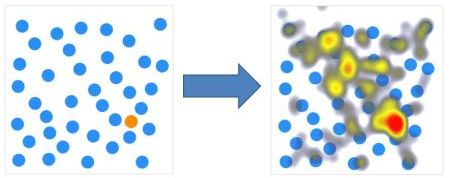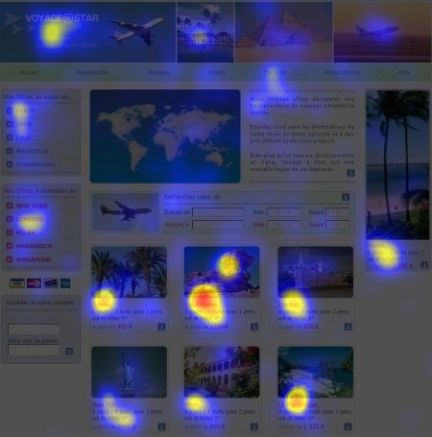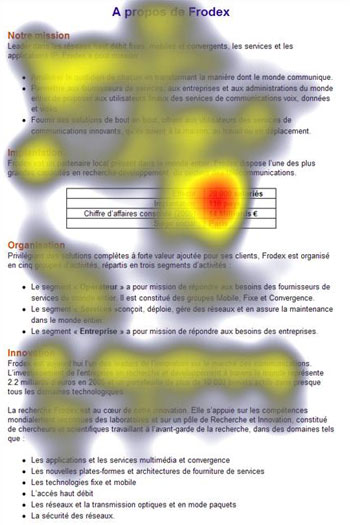There are three factors that determine how a web page is viewed: design, content, and the goal of the user.
There is no single pathway through a web page. Every page is viewed differently and every user looks at pages differently.
There are three elements that influence where a user will look:
- The design of the page
- The content
- The goal of the user
The design of the page
When asked what influences where they look on a page, the most spontaneous answer given by users is page design.
It is logical: the more prominent the area, the more likely it is to attract attention. For example, an area containing bright colors has more chance of drawing the eye.

The orange dot is more prominent than the blue dots.
So logically, people look at it more.
Aside from color, there are a number of other design elements that influence the scan path: page layout, image placement, page length, display resolution, fonts, etc.
So the prominent areas on the page don’t draw the eye every time.
For example, an aggressive ad will be largely ignored. Users understand that it is an ad, based on its position on the page and its format. They will tend to avoid the advertisement area.

The area is prominent and yet it is ignored.
This phenomenon is known as banner blindness.
The content
Users focus on areas that give them the most information for the least effort.
Above all, they look at:
- Concise information (headings, tables, lists, etc.)
- Navigation elements (menus, search boxes, etc.)
- Hyperlinks
- Captioned images

Captions are often the most read elements!

In a text, concise information is the most effective.
On the other hand, the most ignored areas are:
- Areas with low information density (illustrations, general presentation texts, long animations, etc.)
- Areas that are difficult to read or understand (walls of text, fonts that are too small, overly complex patterns, etc.)
The goal of the user
How users look at a page depends entirely on what their goal was when coming to the site.
On e-commerce sites, we often notice two very distinct types of behavior:
- Users who browse leisurely around on the site looking for ideas (open search)
- Users who are looking for a very specific product (focused search)
On one same page, these two user types will obviously behave very differently:

This user is looking for ideas on books to buy. She browses around casually and explores the page. Note that she really focuses on the images that illustrate the text.

This user is looking for a specific product and will not be distracted by page design or content.
The challenge for e-commerce sites is to cater to all types of behavior.
Conclusion
There is more than one way to look at a website.
There are three major elements that determine how a user will look at a page:
- The design of the page
- The content
- The goal of the user
In the next newsletter we will take a first look at how to make your online advertising more effective. It’s a vast subject!
